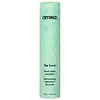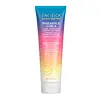What's inside
What's inside
 Key Ingredients
Key Ingredients

No key ingredients
 Benefits
Benefits

 Concerns
Concerns

 Ingredients Side-by-side
Ingredients Side-by-side

Water
Skin ConditioningSodium C14-16 Olefin Sulfonate
CleansingCocamidopropyl Betaine
CleansingGlycerin
HumectantDisodium Cocoamphodiacetate
CleansingPEG-7 Glyceryl Cocoate
EmulsifyingHippophae Rhamnoides Fruit/Seed Oil
AntimicrobialBorago Officinalis Seed Oil
EmollientPersea Gratissima Oil
Skin ConditioningMangifera Indica Seed Butter
Skin ConditioningButyrospermum Parkii Butter
Skin ConditioningHydroxypropyl Guar Hydroxypropyltrimonium Chloride
Lavandula Angustifolia Flower Extract
CleansingChamomilla Recutita Flower Extract
MaskingRosmarinus Officinalis Leaf Extract
AntimicrobialHydrolyzed Quinoa
Skin ConditioningAminomethyl Propanol
BufferingBis-PCA Dimethicone
Butylene Glycol
HumectantSodium Gluconate
Skin ConditioningDisodium PEG-12 Dimethicone Sulfosuccinate
CleansingPEG-12 Dimethicone
Skin ConditioningPEG-150 Distearate
EmulsifyingPolyquaternium-10
Polyquaternium-7
Polysorbate 20
EmulsifyingPropylene Glycol
HumectantGlycol
HumectantGlycol Stearate
EmollientGlycol Distearate
EmollientSodium Methyl Cocoyl Taurate
CleansingCitric Acid
BufferingDehydroacetic Acid
PreservativeBenzyl Alcohol
PerfumingPhenoxyethanol
PreservativePotassium Sorbate
PreservativeSodium Benzoate
MaskingBenzoic Acid
MaskingParfum
MaskingWater, Sodium C14-16 Olefin Sulfonate, Cocamidopropyl Betaine, Glycerin, Disodium Cocoamphodiacetate, PEG-7 Glyceryl Cocoate, Hippophae Rhamnoides Fruit/Seed Oil, Borago Officinalis Seed Oil, Persea Gratissima Oil, Mangifera Indica Seed Butter, Butyrospermum Parkii Butter, Hydroxypropyl Guar Hydroxypropyltrimonium Chloride, Lavandula Angustifolia Flower Extract, Chamomilla Recutita Flower Extract, Rosmarinus Officinalis Leaf Extract, Hydrolyzed Quinoa, Aminomethyl Propanol, Bis-PCA Dimethicone, Butylene Glycol, Sodium Gluconate, Disodium PEG-12 Dimethicone Sulfosuccinate, PEG-12 Dimethicone, PEG-150 Distearate, Polyquaternium-10, Polyquaternium-7, Polysorbate 20, Propylene Glycol, Glycol, Glycol Stearate, Glycol Distearate, Sodium Methyl Cocoyl Taurate, Citric Acid, Dehydroacetic Acid, Benzyl Alcohol, Phenoxyethanol, Potassium Sorbate, Sodium Benzoate, Benzoic Acid, Parfum
Water
Skin ConditioningCetrimonium Chloride
AntimicrobialCetyl Alcohol
EmollientSorbitol
HumectantCaprylic/Capric Triglyceride
MaskingAnanas Sativus Fruit Extract
Skin ConditioningHelianthus Annuus Seed Oil
EmollientBehentrimonium Methosulfate
Cetearyl Alcohol
EmollientPanthenol
Skin ConditioningTocopherol
AntioxidantChamomilla Recutita Flower
Skin ConditioningRubus Idaeus Fruit Extract
AstringentStearamidopropyl Dimethylamine
EmulsifyingEmulsifying Wax Nf
Simmondsia Chinensis Seed Oil
EmollientLecithin
EmollientHyaluronic Acid
HumectantHydrolyzed Soy Protein
HumectantPotassium Sorbate
PreservativeSodium Benzoate
MaskingEthylhexylglycerin
Skin ConditioningParfum
MaskingWater, Cetrimonium Chloride, Cetyl Alcohol, Sorbitol, Caprylic/Capric Triglyceride, Ananas Sativus Fruit Extract, Helianthus Annuus Seed Oil, Behentrimonium Methosulfate, Cetearyl Alcohol, Panthenol, Tocopherol, Chamomilla Recutita Flower, Rubus Idaeus Fruit Extract, Stearamidopropyl Dimethylamine, Emulsifying Wax Nf, Simmondsia Chinensis Seed Oil, Lecithin, Hyaluronic Acid, Hydrolyzed Soy Protein, Potassium Sorbate, Sodium Benzoate, Ethylhexylglycerin, Parfum
 Reviews
Reviews

Ingredients Explained
These ingredients are found in both products.
Ingredients higher up in an ingredient list are typically present in a larger amount.
Parfum is a catch-all term for an ingredient or more that is used to give a scent to products.
Also called "fragrance", this ingredient can be a blend of hundreds of chemicals or plant oils. This means every product with "fragrance" or "parfum" in the ingredients list is a different mixture.
For instance, Habanolide is a proprietary trade name for a specific aroma chemical. When used as a fragrance ingredient in cosmetics, most aroma chemicals fall under the broad labeling category of “FRAGRANCE” or “PARFUM” according to EU and US regulations.
The term 'parfum' or 'fragrance' is not regulated in many countries. In many cases, it is up to the brand to define this term.
For instance, many brands choose to label themselves as "fragrance-free" because they are not using synthetic fragrances. However, their products may still contain ingredients such as essential oils that are considered a fragrance by INCI standards.
One example is Calendula flower extract. Calendula is an essential oil that still imparts a scent or 'fragrance'.
Depending on the blend, the ingredients in the mixture can cause allergies and sensitivities on the skin. Some ingredients that are known EU allergens include linalool and citronellol.
Parfum can also be used to mask or cover an unpleasant scent.
The bottom line is: not all fragrances/parfum/ingredients are created equally. If you are worried about fragrances, we recommend taking a closer look at an ingredient. And of course, we always recommend speaking with a professional.
Learn more about ParfumPotassium Sorbate is a preservative used to prevent yeast and mold in products. It is commonly found in both cosmetic and food products.
This ingredient comes from potassium salt derived from sorbic acid. Sorbic acid is a natural antibiotic and effective against fungus.
Both potassium sorbate and sorbic acid can be found in baked goods, cheeses, dried meats, dried fruit, ice cream, pickles, wine, yogurt, and more.
You'll often find this ingredient used with other preservatives.
Learn more about Potassium SorbateSodium Benzoate is a preservative. It's used in both cosmetic and food products to inhibit the growth of mold and bacteria. It is typically produced synthetically.
Both the US FDA and EU Health Committee have approved the use of sodium benzoate. In the US, levels of 0.1% (of the total product) are allowed.
Sodium benzoate works as a preservative by inhibiting the growth of bacteria inside of cells. It prevents the cell from fermenting a type of sugar using an enzyme called phosphofructokinase.
It is the salt of benzoic acid. Foods containing sodium benzoate include soda, salad dressings, condiments, fruit juices, wines, and snack foods.
Studies for using ascorbic acid and sodium benzoate in cosmetics are lacking, especially in skincare routines with multiple steps.
We always recommend speaking with a professional, such as a dermatologist, if you have any concerns.
Learn more about Sodium BenzoateWater. It's the most common cosmetic ingredient of all. You'll usually see it at the top of ingredient lists, meaning that it makes up the largest part of the product.
So why is it so popular? Water most often acts as a solvent - this means that it helps dissolve other ingredients into the formulation.
You'll also recognize water as that liquid we all need to stay alive. If you see this, drink a glass of water. Stay hydrated!
Learn more about Water